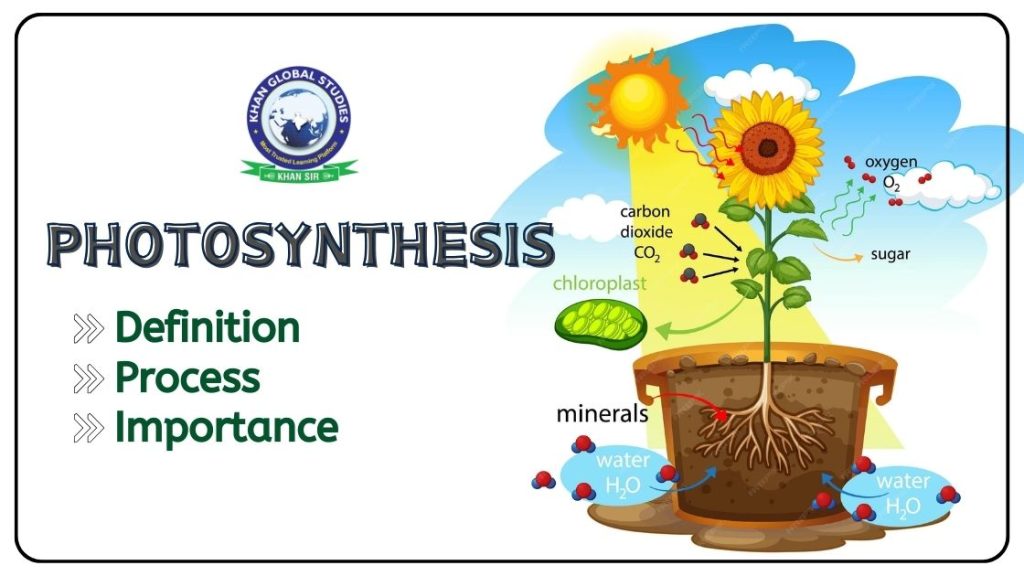The basic process by which plants prepare their food is called Photosynthesis.
In simple words, all green plants are autotrophic. They use raw materials such as carbon dioxide, water and mineral salts to make their food. This process of making food in green plants occurs through it. Green plants make complex substances from simple substances to make their food. They do this process by taking energy from sunlight, which is why the process is called photosynthesis.
All green plants contain chlorophyll which can absorb sunlight. In it, with the help of the Sun’s energy, simple inorganic molecules – Carbon Dioxide (CO2) and Water (H2O) are fixed into Organic Molecules of Glucose (Carbohydrates) in plant cells.
Through this process plants not only produce glucose, but they also fix the radiant energy of sunlight into Chemical Energy, which is stored in Glucose Molecules.
Definition of Photosynthesis
“Photosynthesis is the process in which carbon dioxide and water are converted into glucose in the presence of chlorophyll and light energy.”
Equation of the process of Photosynthesis
We express the entire process of it by the following chemical equation.
6CO2 + 12H2O——-Sunlight and chlorophyll -> C6H12O6 + 6O2 + 6H2O
It is clear from the above equation that in this process oxygen is formed as a by-product, which is released into the atmosphere by the plants.
Sites of Photosynthesis
- The process of photosynthesis continues from beginning to end in chloroplasts. The stalks and spongy parenchyma of the leaves are filled with many chloroplasts. Both the structure and function of these particles are very complex.
- Chlorophyll pigments are found in chloroplasts. Since they are found mostly in the leaves of plants, leaves are called photosynthetic organs and chlorophyll is called the photosynthetic organ.
- Stomata are present in the outer skin or epidermis of leaves. These are special cells which have a hole in the middle. These pores can open and close and are controlled by gate cells or guard cells. Through these stomata, air containing CO2 from the atmosphere reaches the cells inside the leaves by diffusion.
- The opening and closing of stomata depends on the swelling of guard cells. When the guard cells absorb water and swell, the stoma opens. Conversely, when guard cells lose water and shrink, the stoma closes.
Substance Required for Photosynthesis Process
The photosynthesis process requires four substances:
- Chlorophyll,
- Carbon Dioxide,
- Water
- Sunlight.
1. Chlorophyll
As you might know, it occurs only in green plants. But a plant doesn’t need to be green, as red and brown plants also undergo photosynthesis, such as some seagrasses or other plants. Therefore, plant color is not as important in the photosynthesis process as the presence of the green pigment chlorophyll or chlorophyll within plant cells.
Therefore, it is possible only in the presence of chlorophyll. Since chlorophyll is the actual molecule by which the process of photosynthesis occurs, chlorophyll molecules are called photosynthetic units.
2. Carbon-Dioxide (CO2)
During it, plants absorb carbon dioxide and release oxygen. Plants obtain this necessary CO2 from their environment. The largest store of CO2 is the atmosphere. But, apart from these, other gases are also present in different quantities in the atmosphere.
Normally CO2 is present in the atmosphere at 0.03%, i.e. 3 parts CO2 out of 10,000 parts. Apart from this, CO2 is also emitted into the atmosphere due to the burning of wood, coal, fuel, decomposition by bacteria, respiration etc.
3. Water (H2O)
Plants get most of their food from water and they grow because water is an essential component for photosynthesis. It is difficult to show the essentiality of water through any one simple experiment.
If plants do not get regular water they die, but this can happen due to other reasons also. Therefore, farmers should irrigate the crops grown in their fields regularly. This is so that water is regularly available to the plants for the photosynthesis they require. Plants absorb soil-dissolved minerals (compounds of nitrogen, phosphorus, calcium, magnesium, iron, etc.) as well as water from the soil through their roots.
Proteins and other compounds are synthesized from nitrogen. The water absorbed by the roots reaches different parts of the plant and leaves through the xylem tissues where it is used in the process of photosynthesis.
Aquatic plants easily absorb water and salt from their outer parts.
4. Sunlight
It has been experimentally proven that green plants purify carbon dioxide only in sunlight. The process of photosynthesis cannot occur in darkness; Because sunlight provides the energy needed for this process. Chlorophyll present in chloroplasts found in green plants can trap or dissipate solar energy or radiant energy present in sunlight convert it into chemical energy and incorporate it into synthesized glucose molecules.
How does Photosynthesis Occur?
Green plants convert radiation energy into chemical energy in the complex process of photosynthesis. When sunlight falls on green leaves, chlorophyll absorbs the radiation energy and with this energy, the water present in the green leaves gets divided into two parts i.e. hydrogen and oxygen. In these, oxygen comes out through the stomata and gets mixed in the atmosphere.
Hydrogen combines with carbon dioxide to form glucose. Light is not required for the entire process of photosynthesis, but light is required for splitting water i.e. photolysis of water. This first step of photosynthesis is called Light Reaction.
After this reaction in which the product of the light reaction is used to reduce CO2 and form glucose, light and darkness remain equal. This second step of photosynthesis is called a non-light reaction.
This step is not called a non-light reaction because it occurs in darkness or the absence of light is necessary, but the presence or absence of light does not affect it.
Importance of the Photosynthesis Process
It is the primary method of making food in green plants. Carbon and hydrogen oxides (CO2 and H2O) take energy from sunlight and are fixed as carbohydrates (glucose) in plant cells. The chemical equation of it is-
- Plants not only fix carbon dioxide (CO2) and water (H2O) as carbohydrates but also capture energy from the sun. This means that we all consume sunlight indirectly through food every day because plants fix sunlight in the form of food. Animals obtain their food directly from plants and their products and indirectly when they eat other animals as food. Because those animals also depend on plants to fulfil their needs.
- Plants convert sunlight and collect it in the form of organic matter. We take these substances in our food. Oxygen in the air is also produced primarily from the photosynthesis process of plants. Before the origin of plants on Earth, the amount of oxygen gas in the air was negligible. Whatever oxygen existed on Earth at that time was in the form of carbon oxide (CO2, CO) and water (H2O) combined with carbon and hydrogen. The amount of oxygen in the air at present has reached about 20% since the origin of plants and the beginning of it. This process started about 280 crore years ago. The origin and development of higher creatures were possible only due to the presence of oxygen in the air.
This oxygen emitted by it led to the formation of the ‘life-saving’ ozone layer in the Earth’s atmosphere.
- A pigment called chlorophyll is found in green plants. It can capture, convert and transfer energy and make it available to all living beings on Earth.
- In the process of photosynthesis, light energy is converted into chemical energy.
- Apart from green plants, no living organism can directly use solar energy, so all living organisms depend on green plants for their survival.
- Green plants make their organic food from inorganic substances, hence they are called autotrophs, whereas other organisms cannot make their food, hence they are called heterotrophs.
- During the photosynthesis process, oxygen is released into the atmosphere, which makes the environment suitable for other organisms to survive.
- Simple carbohydrates formed through it are converted into lipids, proteins, nucleic acids and other organic substances.
- Green plants and the products made from them are the main food of all living beings.
- Fossil fuels such as coal, gas and oil are also products of plant photosynthesis from ancient geological times.
Where does Photosynthesis take place?
It occurs mainly in the green parts: in the leaves, sometimes also through green stems and flower buds. Chloroplasts are found in specialized cells of leaves called Mesophyll. These chlorophylls are the actual centres of photosynthesis.
Factors Affecting the Rate of Photosynthesis
The factors affecting the rate of photosynthesis can be mainly divided into two parts-
- Internal and
- External (environmental) factors.
Internal factors affecting the rate of photosynthesis
- Chloroplast- The amount of chloroplast is directly related to the rate of photosynthesis because this pigment is light-sensitive and responsible for absorbing sunlight.
- Age and structure of leaf – The rate of synthesis increases as leaf length increases and is highest when the leaf is fully mature. As the leaf gets older, the efficiency of chlorophyll decreases. Many variations affect the rate of photosynthesis in a leaf. As-
i) Number, structure and distribution of stomata.
ii) Size and distribution of intercellular spaces.
iii) Relative proportions of palisade and spongy tissues.
iv) Cuticle thickness, etc.
- Demand for photosynthesis substances- The rate of photosynthesis in fast-growing plants is higher than that of mature plants. When the demand for it is reduced by the removal of meristems, the rate of photosynthesis decreases.
External Factors Affecting the Rate of Photosynthesis
The main external factors affecting the rate of synthesis are temperature, light, carbon dioxide, water minerals etc.
- Intensity of Light
- Light Characteristics
- Photoperiod
- Concept of limiting factors- When a chemical process is affected by more than one factor, the rate of that process depends on the factor that is closest to its minimum value or is present in the lowest amount (or concentration or rate). Depends on that factor. The factor with the least quantity is called the limiting factor.
For example, if the factors required for photosynthesis, heat, light and CO2, are present in sufficient quantity, the rate of photosynthesis will be highest, but if the amount of even one of these factors is less then the rate of photosynthesis will be reduced. This is also called the law of limiting factors or Blackman’s limiting rule.
- Light- The rate of photosynthesis increases with the intensity of light. Only on a cloudy day, light is never the limiting factor. At a specific light intensity, the amount of CO2 used in photosynthesis and CO2 emitted during respiration are the same. This point of light intensity is called the adjustment point. The wavelength of light also affects it. Red light and to a lesser extent blue light increase the rate of photosynthesis.
- Temperature- Too high and too low temperatures reduce the rate of photosynthesis. The rate of photosynthesis increases from 5o – 37oC, but at temperatures higher than this it decreases rapidly because the enzymes participating in the light reaction become inactive at higher temperatures. For every 10oC increase in temperature between 5o – 37oC, the rate of photosynthesis doubles i.e. Q10 = 2 (Q = coefficient).
- Carbon Dioxide- CO2 is the main raw material of photosynthesis. Therefore, its concentration or quantity majorly affects photosynthesis. Due to its low abundance in the environment (0.03%) it occurs naturally as a limiting factor. If the supply of CO2 is increased at favorable temperatures and light intensity, the rate of photosynthesis will increase significantly
- Water- H2O indirectly influences the rate of photosynthesis. Due to lack of water in the soil, the stomata will get closed due to which the plant will not face shortage of water. Hence, CO2 will not be absorbed from the atmosphere which photosynthesis will reduce.
- Mineral compounds- Some mineral compounds like copper, manganese chloride etc. are part of photosynthetic enzymes and magnesium is part of chlorophyll. Therefore, they also indirectly affect the rate of photosynthesis, as they are the main components of chlorophyll and enzymes.
Discovery and Opinion of Various Scientists on Photosynthesis
- Aristotle- believed that light is necessary for the growth of plants.
- Stephen Hales (1722) first reported that light is essential to the process by which plants obtain nutrition from the atmosphere.
- Senebier (1782)- reported that carbon dioxide is necessary for plants to release oxygen.
- Mayer (1842)- reported that the light energy absorbed by plants is converted into chemical energy by the process of photosynthesis.
Based on detailed studies by 1900, it was demonstrated by the following equation:
6CO2 + 6H₂0 + light + energy —-> C6H12O6 + 602 - Priestley (1722)- reported that plants exchange gases like animals, but this process of plants purifies the atmosphere.
- O. Warburg- Other scientists proved that both these reactions occur independently.
- Ingenhausen (1779)- declared light and chlorophyll to be essential for the process of photosynthesis.
- Blackman (1905)- based on his important detailed experiments, surprisingly demonstrated that photosynthesis occurs in at least two series of reactions.
i) Light reaction- A non-chemical reaction that requires light.
ii) Dark reaction or Blackman reaction- a chemical-enzymatic reaction that requires CO2 and does not require light.
FAQs
Question:- What is the Photosynthesis process?
Answer:- This process of making food in green plants happens through photosynthesis. Green plants make complex substances from simple substances to make their food. They do this by taking energy from sunlight, which is why the process is called photosynthesis.
Question:- How does Photosynthesis occur?
Answer:- It is the process by which green plants produce carbohydrates by combining water and carbon dioxide in the presence of sunlight and oxygen is released as a by-product in this process.
Question:- What is Photosynthesis?
Answer:- It is the process in which light energy is converted into chemical energy. Carbohydrates such as sugar are synthesized from carbon dioxide and water using light energy.
Question:- Where is Photosynthesis found?
Answer:- Photosynthesis in plants usually occurs in leaves. This process is enabled by a green pigment called chlorophyll, which absorbs sunlight, present in the chloroplasts found in leaves. The process of photosynthesis helps plants make food for themselves.
Question:- What is the common product of photosynthesis and respiration?
Answer:- The processes of photosynthesis and respiration are complementary and opposite to each other. In photosynthesis, a chemical reaction between carbon dioxide and water results in glucose being formed and oxygen being released. In contrast, respiration results in the oxidation of glucose to form water and carbon dioxide.
Question:- Which photosynthetic pigments are found inside plant cells?
Answer:- Chlorophyll (green color of leaves), light and carbon dioxide (CO2) inside the plant cell are necessary for photosynthesis.
Question: Why is the husk called a photosynthetic organ?
Answer:- The process of photosynthesis takes place from beginning to end in chloroplast. Chlorophyll pigments are found in chloroplasts. These are found in the leaves of most plants. Therefore leaves are called photosynthetic organs.
Question: When does photosynthesis occur, during the day or at night?
Answer:- The process of photosynthesis takes place during the day in the presence of sunlight.
Question:- What is a Photosynthetic Pigment?
Answer:- Pigments are present in plants that absorb the light energy of the sun. Are called photosynthetic pigments. Three types of photosynthetic pigments are found in different plants.
Question:- What is the first step of photosynthesis?
Answer:- In the first step of photosynthesis, the light reaction starts with the absorption of sunlight and this reaction brings one electron of the center into the excited state. Since the reaction centre is a specialized chlorophyll-a molecule, the first step in the light reaction is the excitation and release of an electron from chlorophyll-a.
Question:- Which gas is released in the process of photosynthesis?
Answer:- Explanation: Plants absorb carbon dioxide (CO2) gas in the process of photosynthesis, as the reaction of carbon dioxide and water produces carbohydrates and oxygen gas. That is, oxygen gas is released in this process.




